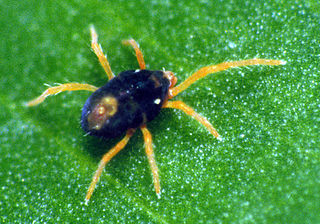
Mites are small arachnids. Mites span two large orders of arachnids, the Acariformes and the Parasitiformes, which were historically grouped together in the subclass Acari. However, most recent genetic analyses do not recover the two as each other's closest relative within Arachnida, rendering the group non-monophyletic. Most mites are tiny, less than 1 mm (0.04 in) in length, and have a simple, unsegmented body plan. The small size of most species makes them easily overlooked; some species live in water, many live in soil as decomposers, others live on plants, sometimes creating galls, while others are predators or parasites. This last type includes the commercially destructive Varroa parasite of honey bees, as well as scabies mites of humans. Most species are harmless to humans, but a few are associated with allergies or may transmit diseases.

Tarsonemus is a genus of trombidiform mites within the family Tarsonemidae.

The austral snipes, also known as the New Zealand snipes or tutukiwi, are a genus, Coenocorypha, of tiny birds in the sandpiper family, which are now only found on New Zealand's outlying islands. There are currently three living species and six known extinct species, with the Subantarctic snipe having three subspecies, including the Campbell Island snipe discovered as recently as 1997. The genus was once distributed from Fiji, New Caledonia and Norfolk Island, across New Zealand and southwards into New Zealand's subantarctic islands, but predation by introduced species, especially rats, has drastically reduced their range.

Prostigmata is a suborder of mites belonging to the order Trombidiformes, which contains the "sucking" members of the "true mites" (Acariformes).
The Raphignathoidea is a superfamily of the Acari (mite) order Trombidiformes, comprising 1087 species in 62 genera and 12 families.

Lorryia formosa, commonly known as the yellow mite or the citrus yellow mite, is a species of acariform mite. They are in the subfamily Tydeinae of the family Tydeidae. Commonly found on the foliage of citrus trees around the world, Lorryia formosa also associates with a variety of other plant types. The life cycle includes six discrete stages of development, and the lifespan averages about 37 days. The females of the species use an asexual form of reproduction where the growth and development of embryos occurs without fertilization by a male, a process called thelytoky.
Austrophthiracarus is a genus of mites in the family Steganacaridae.
Antennoseius is a genus of mites in the family Ascidae. As of 2021, it comprised 59 species mostly in subgenera Antennoseius and Vitzthumia, as well as six species not assigned to a subgenus.

Bryobia is a genus of mites in the spider mite family, Tetranychidae. The taxonomy of the genus is difficult. The genus has been revised several times. It is difficult to distinguish these tiny species from each other on the basis of morphological characters, and there is little agreement on which characteristics are of importance. Also, species can be variable in morphology. Over 130 species have been described, but many of the names are likely synonyms.
Neophyllobius is a genus of mites.

Eupodoidea is a superfamily of mites in the order Trombidiformes. There are about 8 families and more than 160 described species in Eupodoidea.

Penthaleus major, known generally as the winter grain mite or blue oat mite, is a species of earth mite in the family Penthaleidae. They are black or dark blue in color and are widespread across the world. They are commonly found on oats and in pastures and spend most of their time on the surface of soil, and are occasionally found on wheat, barley, peas, lentil and lucerne, and seldom on canola.
Charletonia is a genus of mites belonging to the family Erythraeidae.

Halotydeus is a genus of earth mites in the family of Penthaleidae, first described by Antonio Berlese in 1891.
Eriorhynchidae is a family in the order Trombidiformes described by Qin & Halliday, 1997. There have been observations along the East Coast of Australia.
Eriorhynchus australicus is a species in the genus Eriorhynchus
Eriorhynchus hades is a species in the genus Eriorhynchus.
Eriorhynchus ramosus is a species in the genus Eriorhynchus.
Eriorhynchus walteri is a species in the genus of Eriorhynchus.
Eriorhynchus womersleyi is a species of mite in the genus of Eriorhynchus.








